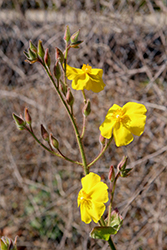Fri & Sat 8am - 8pm
Sun 8am - 7pm
Anytown, USA 12345
fax: 261.787.0463
e-mail: info@successgc.com


Plant Finder

Height: 5 feet
Spread: 4 feet
Sunlight:
![]()
Hardiness Zone: 9b
Other Names: syn. Halimium atriplexifolium, Rock Rose
Description:
Clusters of dazzling yellow flowers in spring, on stems covered with red hairs, over the attractive, silvery gray-green foliage; a great rock garden or landscape accent; tolerant of poor, dry soils, hot garden locations and salt spray
Ornamental Features
Yellow Rockrose is smothered in stunning clusters of yellow round flowers with white eyes and gold anthers at the ends of the branches from mid spring to early summer, which emerge from distinctive brick red flower buds. It has attractive grayish green foliage with gray undersides and tinges of silver. The recurved oval leaves are highly ornamental and remain grayish green throughout the winter. The hairy tan bark and green branches add an interesting dimension to the landscape.
Landscape Attributes
Yellow Rockrose is a multi-stemmed evergreen shrub with a mounded form. Its average texture blends into the landscape, but can be balanced by one or two finer or coarser trees or shrubs for an effective composition.
This is a relatively low maintenance shrub, and should only be pruned after flowering to avoid removing any of the current season's flowers. Deer don't particularly care for this plant and will usually leave it alone in favor of tastier treats. It has no significant negative characteristics.
Yellow Rockrose is recommended for the following landscape applications;
- Accent
- Hedges/Screening
- Rock/Alpine Gardens
- General Garden Use
- Container Planting
Planting & Growing
Yellow Rockrose will grow to be about 5 feet tall at maturity, with a spread of 4 feet. It tends to fill out right to the ground and therefore doesn't necessarily require facer plants in front, and is suitable for planting under power lines. It grows at a medium rate, and under ideal conditions can be expected to live for approximately 10 years.
This shrub should only be grown in full sunlight. It prefers dry to average moisture levels with very well-drained soil, and will often die in standing water. It is considered to be drought-tolerant, and thus makes an ideal choice for xeriscaping or the moisture-conserving landscape. This plant should not require much in the way of fertilizing once established, although it may appreciate a shot of general-purpose fertilizer from time to time early in the growing season. It is not particular as to soil type or pH, and is able to handle environmental salt. It is somewhat tolerant of urban pollution. This species is not originally from North America.
Yellow Rockrose makes a fine choice for the outdoor landscape, but it is also well-suited for use in outdoor pots and containers. Because of its height, it is often used as a 'thriller' in the 'spiller-thriller-filler' container combination; plant it near the center of the pot, surrounded by smaller plants and those that spill over the edges. It is even sizeable enough that it can be grown alone in a suitable container. Note that when grown in a container, it may not perform exactly as indicated on the tag - this is to be expected. Also note that when growing plants in outdoor containers and baskets, they may require more frequent waterings than they would in the yard or garden.
